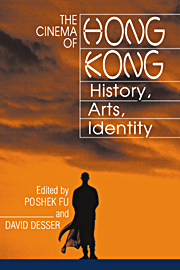Book contents
- Frontmatter
- Contents
- List of Contributors
- Acknowledgments
- Introduction
- Chronology of Hong Kong Cinema
- PART I HISTORY
- 1 The Kung Fu Craze: Hong Kong Cinema's First American Reception
- 2 The American Connection in Early Hong Kong Cinema
- 3 The 1960s: Modernity, Youth Culture, and Hong Kong Cantonese Cinema
- 4 The 1970s: Movement and Transition
- PART II ARTS
- PART III IDENTITY
- Index
1 - The Kung Fu Craze: Hong Kong Cinema's First American Reception
Published online by Cambridge University Press: 05 June 2012
- Frontmatter
- Contents
- List of Contributors
- Acknowledgments
- Introduction
- Chronology of Hong Kong Cinema
- PART I HISTORY
- 1 The Kung Fu Craze: Hong Kong Cinema's First American Reception
- 2 The American Connection in Early Hong Kong Cinema
- 3 The 1960s: Modernity, Youth Culture, and Hong Kong Cantonese Cinema
- 4 The 1970s: Movement and Transition
- PART II ARTS
- PART III IDENTITY
- Index
Summary
A SUDDEN STORM
When Jackie Chan's Rumble in the Bronx opened in February 1996 and quickly became the top box-office draw of the month, film fans over forty may have been forgiven for a nagging, if not ironic, sense of déjà vu. This was not the first time the American box-office had been taken by storm by a Hong Kong superstar; and not the first time a formulaic film, the product of an internationally popular and powerful foreign film industry heretofore under appreciated by U.S. audiences, caught most critics and audiences unawares. Twenty-three years earlier, in 1973, American audiences thrilled to the exploits of Bruce Lee – and Bruce Lee's films were not alone at the top of the charts. That May, perhaps for the first and only time in the history of the American cinema, not one, not two, but three foreign-made films took home the week's top box-office grosses. This unprecedented accomplishment seems to have gone unremarked at the time.
Jackie Chan's popularity among mainstream U.S. audiences waned quickly. In a sad but consistent manner, each film released subsequent to Rumble in the Bronx performed less well: Supercop did less business than Rumble (Rumble grossed $32.3 million; Supercop, $16.25); Jackie Chan's First Strike earned less than Supercop ($14.5 million), and Operation Condor earned even less than First Strike ($10.4 million). Many factors might account for this, but it is not this chapter's intention to try.
- Type
- Chapter
- Information
- The Cinema of Hong KongHistory, Arts, Identity, pp. 19 - 43Publisher: Cambridge University PressPrint publication year: 2000
- 53
- Cited by

